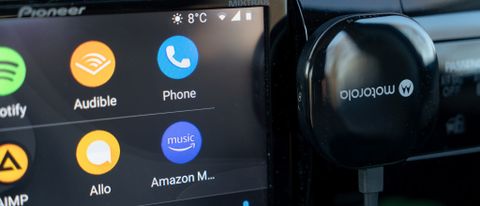Android Central Verdict
The Motorola MA1 is a simple product with a single purpose, and that's to let you use Android Auto wirelessly. It can do that without question, but you will have to consider a few things before you go for it.
Pros
- +
Nice design
- +
Easy setup
- +
Similar experience while wireless
- +
No loss in controls
- +
Opens up possibilities in the cabin
Cons
- -
Included adhesive isn't great
- -
No software or firmware updates
- -
Short cable could make placement tricky
- -
Slower startup
Why you can trust Android Central
Once you go wireless with Android Auto, it's hard to go back, and Motorola thinks it has the gizmo to make that happen, no matter what car you have. Granted, you do need to be able to run the platform to begin with, but if you've always had to plug in via USB to make it happen, this device may let you untether it.
With such a simple premise, you would expect the results to be just as straightforward. For the most part, they will be, though you do have to deal with some challenges along the way.
Motorola MA1: Price and availability
Motorola announced and launched the MA1 in January 2022 and has held steady since at its original $90 price tag. That may change in due course, though, especially if Motorola adds to its in-car gadget lineup with similar products.
Motorola MA1: What's good

It's always nice when a small device has one job to do because it's easier to set and meet expectations. That's exactly how I looked at the Motorola MA1 when I got my hands on it. I knew what it was supposed to do, so my curiosity was more about how robust and consistent it would be.
But first, I had to figure out where I was going to put it. It's not so much about the size because the MA1 isn't big; it's more about where the car's USB port is. In my case, I have a Pioneer aftermarket head unit installed in mine that has its own USB port by way of a separate cable that comes out near the glove compartment. I could leave the device dangling and lay it down under the passenger seat or use the included adhesive pad to position it somewhere on the dash.
It was pretty smooth, and liberating to see myself running it on a 2014 model vehicle.
I settled on a spot next to the head unit screen because the pad seemed to stick best to the glossier surface. I don't know why, but it just did. The rest of the setup was pretty straightforward in that I had to pair with the MA1 via Bluetooth and run through the Android Auto setup to get the sequence working. Once done, I could unplug my phone, plug in the MA1, and then have a wireless tether going to run the platform.
It was pretty smooth and liberating to see myself running it on a 2014 model vehicle. Every subsequent time I turned the car on, it would take about 20 seconds or so to get everything going on. Obviously not as instantaneous as using a cable, but hey, I'll take it if it means I can leave my phone free or use a wireless charging dock instead.

That is one of the pain points the MA1 can solve, which is to make a wireless charger actually useful, especially if you're driving a vehicle that includes it. There are plenty out there that have them — yet also force you to plug in to use Android Auto, which charges the phone at the same time anyway. Using the MA1 alters that reality in a big way, including if your car doesn't have a wireless charging pad. Get a third-party dock, and you've got a pretty slick setup inside the cabin.
What's even better is that, despite the slower startup, the rest of the Android Auto experience doesn't feel any different. The interface was just as responsive, steering wheel controls work the same way, and so do voice commands. It's not a perfect transition, mind you, and I'll get to that, but general usability left a lot to like.
Even better was that the wireless connection didn't kill my phone's battery. I mostly tested it with the Pixel 6 Pro, and at worst, the MA1 just sipped a little power over the course of a drive. It was pretty negligible, and even at lower battery levels, I was fine. I could always plug in through a 12V socket charger if I wanted to charge the phone faster.
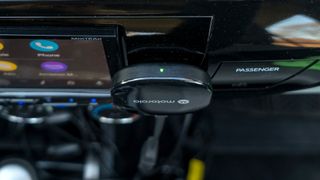
The MA1 doesn't have its own dedicated app or any software method to interface with it directly. Only the main button on the side and the LED light stand as manual inputs or visible cues, so I don't know if Motorola is able to push firmware updates to this thing. If not, then I'm also unclear on whether Android Auto itself or software on a paired phone, helps fill any performance gaps.
Thing is, it is connecting to the phone via Bluetooth and does need a 5GHz connection. One thing I didn't have a chance to try is to see how the device works in tandem with an in-car Wi-Fi hotspot. Plenty of vehicles offer hotspots, yet also don't do wireless Android Auto. It they can work together, that would be awesome, but I don't know for sure.
Motorola MA1: What's not good
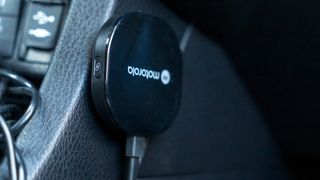
One of my concerns with the MA1 is what happens when it's time to switch phones or vehicles. Bluetooth pairings don't make the transition, even if you are migrating from one phone directly to another, which means you have to pair the MA1 all over again. To do so, you have to put it back to factory settings through a series of button presses where the LED changes color to indicate its status.
I bring this up because the original MA1 Motorola sent me failed to factory reset properly, so they sent a replacement owing to the original possibly being defective. I didn't try factory resetting the second one, but it otherwise functioned without any connectivity problems.
It's one of the potential pitfalls of a device that, while singularly focused, doesn't have an easy way to interface with it when something doesn't seem right. You may never run into any problems, and resetting it might never be an issue, but as a piece of advice, I would try the reset process first before unpairing it from your phone, in case you're troubleshooting anything. Losing that connection means the MA1 is running blind.
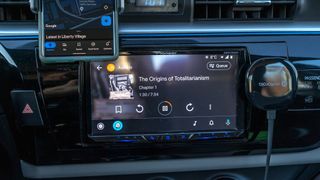
I also bring up software and troubleshooting because it's hard to know what to do to fix anything that might come up, or even if the MA1 is responsible. The LED is the only indication that something might be wrong, but even then, it's not a tell. For instance, flashing green means the device is trying to connect, and a solid light means it has. If the light is solid, yet you're not getting a connection, it's hard to understand what to do.
Motorola's troubleshooting steps are limited, and the factory reset is likely going to be your go-to in case things really go awry. My second review unit worked without issue, so I can't complain. I'm just not sure about further down the line, and for someone who isn't as tech-savvy, troubleshooting this thing would feel tenuous.
It also struggles to stick to textured surfaces, which are pretty common in dashboards and vehicle interiors.
Also, the adhesive pad Motorola provides isn't the best. I do like that it doesn't leave residue, only it also struggles to stick to textured surfaces, which are pretty common in dashboards and vehicle interiors. This matters more because of the USB ports' location in the car. They can be at the front or in the center console. They might even be in front of a wireless charging pad. Placement is a tricky business if faced with situational challenges like that.
Not a big deal, in the grander scheme, but something to consider if you feel the device could somehow get in the way.
Motorola MA1: Competition

Dongles for wireless Android Auto aren't abundant, but Motorola definitely doesn't hold a monopoly, either. The AAWireless is a very similar product that can perform well, albeit with less retail availability. If you're more technically inclined, you might want to try the Carlinkit, which is as much an infotainment replacement as something that simply makes Android Auto wireless.
Alternatively, you can always go wired if the MA1 doesn't work out, or you prefer to tether that way. It's still pretty bulletproof and charges your phone all at once.
Motorola MA1: Should you buy it?
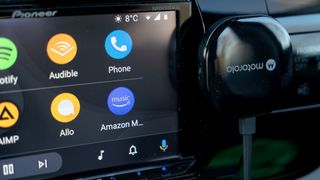
You should buy this if...
- You want wireless Android Auto
- You drive a vehicle with no other option but wired Android Auto
- You want your phone free wirelessly charge
- You know exactly where you would place it
You shouldn't buy this if...
- You are fine with wired Android Auto
- You don't have a wireless charger
- You would rather use something with an app
- You're not sure where you would place it
It may come with the potential for headaches at some point, but that's also speculative, and given what the MA1 can do, it is worth giving it a shot. Wireless Android Auto is just awesome, and the flexibility it gives for either charging your phone wirelessly, or simply docking it without a cable sticking out of it, should feel liberating.
It's unclear how Android OS updates might improve the MA1's performance, so that remains to be seen. All in all, it's a utility product that has one job to do, and when all goes well, it does that one job fairly well.
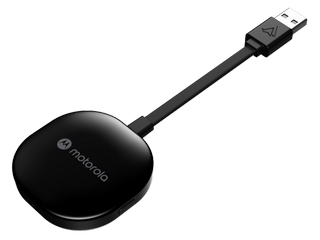
The Motorola MA1 is designed to free you from a wired Android Auto experience, and once you plug it in, it's supposed to keep it that way.

Ted Kritsonis loves taking photos when the opportunity arises, be it on a camera or smartphone. Beyond sports and world history, you can find him tinkering with gadgets or enjoying a cigar. Often times, that will be with a pair of headphones or earbuds playing tunes. When he's not testing something, he's working on the next episode of his podcast, Tednologic.
